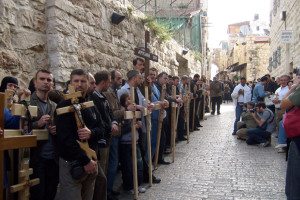JERUSALEM—Strands of gold entwined with copper, wrapped in the folds of a towering wall, the scent of pines carried on the breeze at twilight, the sound of bells punctuating the slumber of tree and stone. Lying in proud solitude, its mountain air as clear as wine, its name scorching like the kiss of a seraph. We are looking down on the little town of Jerusalem, city of gold, of which the poets and troubadours never tire of singing. Israel’s Ofra Haza calls it Yerushalaym shel zahav (Jerusalem of Gold) and Lebanon’s Fayrouz zahratul mada en (flower of the cities).

We are in the process of carrying out some aerial filming. The helicopter hovers impatiently in the spring air, the 65 mm. camera in its bosom hungrily lapping up the landscape unraveling below, creating the backdrop for what the producers and director are confident will be a triumphant celebration of Jerusalem.
Like busy ants, the thousands of pilgrims down below push and pull each other in their haste and eagerness to join a procession or reach a gate before a logjam develops and they are left out in the cold, sometimes for hours.
They are here to celebrate Easter, 2010. The concatenation of ceremonies this particular leap year has exacerbated a perennially congested logistics problem, creating headaches not only for church leaders who must accommodate their flock, but also for the outnumbered police who must impose order and a sense of security and ensure all things run smoothly.
Religious ceremonies follow one another back to back in an endless run of astute stage management and euphoric expectations as members of the various Christian churches—Catholic, Protestant, and Orthodox (Armenian, Greek, Assyrian, Coptic, Ethiopian)—crane necks or seek vantage points, some clinging perilously to rooftops, as they seek to view, absorb, and store in their memories echoes of the sacred moments they are experiencing.
In years past, when the crowds were thinner, scuffles between two or three different Christian denominations, almost invariably involving Greeks and Armenians, had come to be the expected norm. Disagreements would break out over each side’s private interpretation of the terms of the long-standing status quo that governs relations between the various Christian churches, an inheritance from the Ottoman regime. With territorial rivalry running rampant over ownership of the holy sites, breaches of the status quo are always viewed with zero tolerance: You sweep one extra tile beyond your jurisdiction, and you are encroaching on my rights and privileges.
With these and other sensitivities in mind, our production team worked hard to establish solid rapport with the leaders of the Christian churches, as well as with leaders of the neighborhood Muslim and Jewish communities. We have almost carte blanche to film whenever and wherever we want.
Almost.
Although I am allowed to videotape the relics of Armenian saints (encased in gilt silver containers shaped like forearms) housed in a chapel that is ordinarily out of bounds, I am denied access to the treasury of the Armenian Patriarchate, whose location is a closely guarded secret, and whose portals require three separate keys wielded by three different priests to open.
And the Waqf, the institution that oversees Muslim religious sites, demands that we stop the cameras rolling when the sheikh mounts the minbar (pulpit) to deliver the Friday sermon at the Aqsa Mosque, the third most important place of worship for Islam after Mecca and Medina.
The weather is unimpeachable and the spacecam delivers beautiful footage of the Dead Sea, Qumran, Nazareth, the distant Judean hills, and other major landmarks of the Holy Land in a wide sweep of a predetermined grid pattern.
I am down on the ground doing my bit. This is my second trip to Jerusalem in 15 years. I have been brought over as project consultant, but soon after I land, a camcorder is thrust into my hands. What I film will complement our mushrooming research material and help make an informed decision about what to include in the final cut.
For the first time in years, there are no incidents to mar the festive spirit. Sensible heads have prevailed and have been able to contain any nascent sparks that could lead to a potential flareup. The only jarring note is the immense difficulty hundreds of hapless pilgrims face in trying to run the gamut of makeshift checkpoints the Israeli police have erected at every corner and junction of the Old City streets and alleys.
I have a personal experience of this anomaly: Armed with a couple of passes issued by the Armenian Patriarchate, I am trying to get two production team members past one checkpoint at Jaffa Gate, only to be rebuffed and told to try the nearby New Gate or the more distant Zion Gate. Although I carry an itonai chutz (foreign correspondent) pass as well as “permission” letters of reference from all three Guardians of the Holy Places (Armenians, Greeks, and Custodia) allowing us free access to the Holy Places, the police officer is unimpressed.
“If I let your people pass, I must let everyone else pass as well,” he tells me, waving at the milling multitude behind the barricade.
As I stand there fuming, one of the pilgrims at the checkpoint pleads with me to give her a pass. I shake my head helplessly. I only have the two.
The team members finally make it through but only after we place a call with the Jerusalem police chief.
We barely have time to join the Armenian procession to the Church of the Holy Sepulchre.
As we plod through the cobblestone streets of the Old City, I tell myself that it is through these roads the son of the carpenter from Nazareth must have passed on his mission of peace and forgiveness, and his eventual condemnation and punishment.
And here we are, 2,000 years later, re-enacting his painful march to his place of crucifixion.
And ultimate triumph over death, and his resurrection on the Holy Fire Saturday we are witnessing.


Be the first to comment